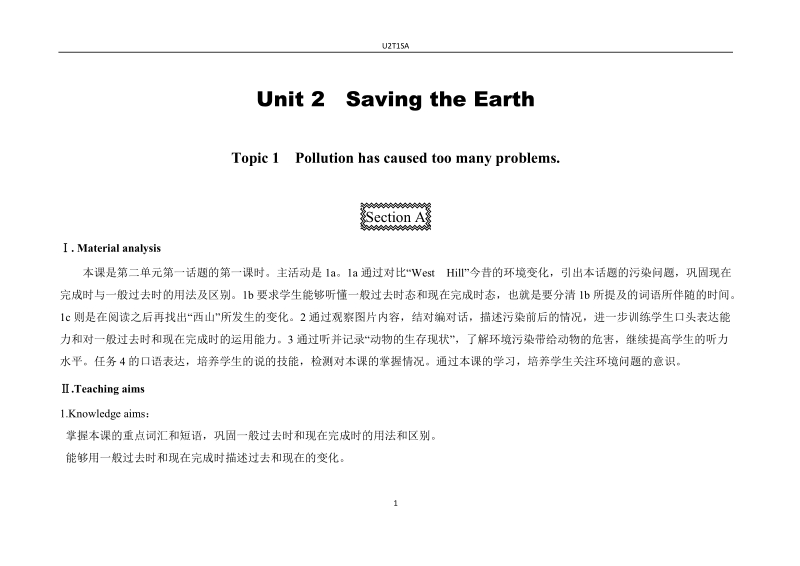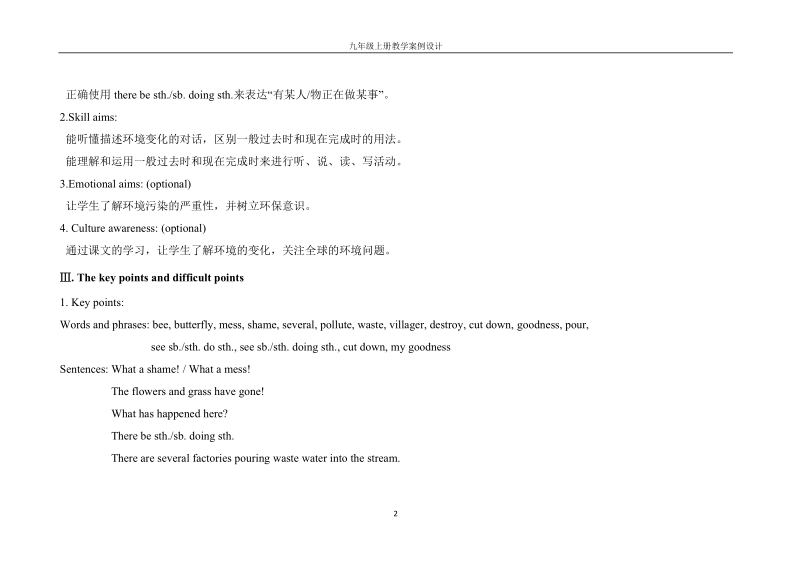 仁爱版九年级英语上册Unit2 Topic1 Section A教案
仁爱版九年级英语上册Unit2 Topic1 Section A教案
《仁爱版九年级英语上册Unit2 Topic1 Section A教案》由会员分享,可在线阅读,更多相关《仁爱版九年级英语上册Unit2 Topic1 Section A教案(12页珍藏版)》请在七七文库上搜索。
1、U2T1SA1Unit 2 Saving the EarthTopic 1 Pollution has caused too many problems.Section A. Material analysis本课是第二单元第一话题的第一课时。主活动是 1a。1a 通过对比“West Hill”今昔的环境变化,引出本话题的污染问题,巩固现在完成时与一般过去时的用法及区别。1b 要求学生能够听懂一般过去时态和现在完成时态,也就是要分清 1b 所提及的词语所伴随的时间。1c 则是在阅读之后再找出“ 西山”所发生的变化。2 通过观察图片内容,结对编对话,描述污染前后的情况,进一步训练学生口头表达能力
2、和对一般过去时和现在完成时的运用能力。3 通过听并记录“动物的生存现状” ,了解环境污染带给动物的危害,继续提高学生的听力水平。任务 4 的口语表达,培养学生的说的技能,检测对本课的掌握情况。通过本课的学习,培养学生关注环境问题的意识。.Teaching aims1.Knowledge aims: 掌握本课的重点词汇和短语,巩固一般过去时和现在完成时的用法和区别。能够用一般过去时和现在完成时描述过去和现在的变化。九年级上册教学案例设计2正确使用 there be sth./sb. doing sth.来表达“ 有某人/物正在做某事” 。2.Skill aims: 能听懂描述环境变化的对话,区别
3、一般过去时和现在完成时的用法。能理解和运用一般过去时和现在完成时来进行听、说、读、写活动。3.Emotional aims: (optional)让学生了解环境污染的严重性,并树立环保意识。4. Culture awareness: (optional)通过课文的学习,让学生了解环境的变化,关注全球的环境问题。. The key points and difficult points1. Key points: Words and phrases: bee, butterfly, mess, shame, several, pollute, waste, villager, destroy,
4、cut down, goodness, pour,see sb./sth. do sth., see sb./sth. doing sth., cut down, my goodnessSentences: What a shame! / What a mess!The flowers and grass have gone!What has happened here?There be sth./sb. doing sth.There are several factories pouring waste water into the stream.U2T1SA3Everything has
5、 changed.Grammar: differences between Simple Past and Present Perfect tense. 2. Difficult points: 正确使用 there be sth./sb. doing sth.来表达“ 有某人/物正在做某事” 。区别使用短语 see sb./ sth. do sth.和 see sb. / sth. doing sth.。能正确地以口头和书面形式区别使用一般过去时和现在完成时。. Learning strategies通过引导学生在听前阅读 1b 和 3,培养学生形成听前熟悉、预测听力材料的习惯。通过朗读 1
6、a 和 2,引导学生模仿已有对话,编写新的对话。通过 1c,培养学生整合对话信息,将对话转换为语篇的能力。. Teaching aids图片(关于校园周边环境变化对比图或者影像资料) ,录音机,幻灯片等。. Teaching procedures Stage(time period)InteractionpatternsTeacher activity Student activity Remarks1 Getting Class activity Greet and talk about the weather. Lead the Greet and focus their attentio
7、n 通过谈论天气,要去野炊,九年级上册教学案例设计4students ready for learning(1 min)Ss to discuss the right place for a picnic.T: Hi, boys and girls! Its a nice day, isnt it?Ss: Yes.T: Would you like to have a picnic with me?Ss: Id like that./Sounds great.T: So where shall we go?Ss.on the teacher.Ss: Yes.Ss: Id like that./
8、Sounds great.Ss.吸引学生的注意力,也符合课文主题,使学生专注于课堂。如果天气不好,也可以做好周末的野炊计划。2Lead-in (3-5 mins)Group workLet the Ss discuss where to have a picnic. Encourage them to state the reasons.T: Now work in groups, choose the best place for a picnic and tell the class why you choose that place.SsT: OK, tell us where to h
9、ave a picnic. Why?S1: I think is the best choice. The air there is fresh. We can fly kites on the grass.Discuss where to have a picnic and state the reasons.SsS1: I think is the best choice. The air there is fresh. We can fly 先让学生讨论出合适的野炊地点,老师再出示西山没被污染的图片来吸引学生的注意。当学生兴趣高涨时,又呈现被污染后的图片,让学生满怀兴趣和疑问去了解西山被
10、污染前后的状况,更好的体会一般过去时和现在完成时在U2T1SA5S2kites on the grass.S2语境中的运用,同时也突破了单词关。3Pre-listening(5-7 mins)Class activityPresent two pictures of the West Hill and describe the changes. Teach the new words and some difficult sentences.(Show the old picture of the West Hill to the Ss)T: Look at this beautiful pi
11、cture. Kangkang and his friends had a picnic there two years ago. Can you guess where it is?Ss: Yes, its the West Hill.T: What can you see in the picture?S1: Some flowers, a clean river and a big treeT: Right. The West Hill is a beautiful place. Can you see the bees and butterflies dancing thereWatc
12、h the pictures of the West Hill, guess the meaning and pronunciation of the words according to the introduction about the changes of the West Hill.Ss: Yes, its the West Hill.S1: Some flowers, a clean river and a big tree在教授新单词时,老师应当同时呈现单词和音标,让学生运用所学音标自己解决单词的读音问题,如果学生发音不准,老师要及时更正。再根据图片和讲解,引导学生大胆的猜测词义
13、和部分难句的意思,为 1a 中的听力对话扫障碍。九年级上册教学案例设计6(Point to the bees and butterflies, and then write down the words and phrases on the Bb)T: So do you want to go there for a picnic?Ss: YesT: Id like to. But now it has changed a lot. Look at this picture. Do you like it?Ss: No.(Teacher presents the new words and d
14、ifficult sentences through the description of the picture.)Ss: YesSs: No.4While-listening(10 mins)Individual work Step 1: Let the Ss listen to 1a twice and do 1b alone.T: Listen to the tape carefully and try to mark the words with P or N.T: Now please check answers in your group.Listen and mark the



- 配套讲稿:
如PPT文件的首页显示word图标,表示该PPT已包含配套word讲稿。双击word图标可打开word文档。
- 特殊限制:
部分文档作品中含有的国旗、国徽等图片,仅作为作品整体效果示例展示,禁止商用。设计者仅对作品中独创性部分享有著作权。
- 关 键 词:
- 仁爱 九年级 英语 上册 Unit2Topic1SectionA 教案
 七七文库所有资源均是用户自行上传分享,仅供网友学习交流,未经上传用户书面授权,请勿作他用。
七七文库所有资源均是用户自行上传分享,仅供网友学习交流,未经上传用户书面授权,请勿作他用。



 浙公网安备33030202001339号
浙公网安备33030202001339号
链接地址:https://www.77wenku.com/p-34395.html